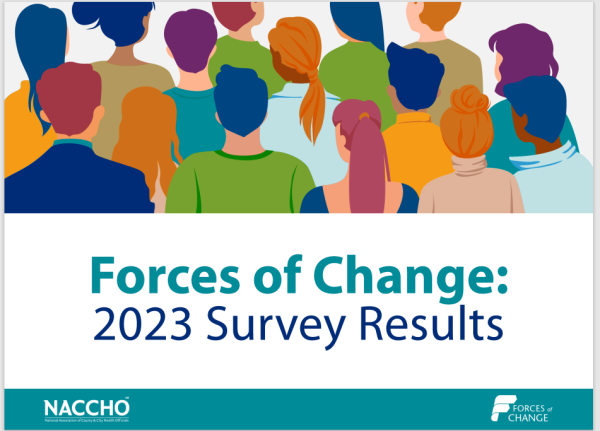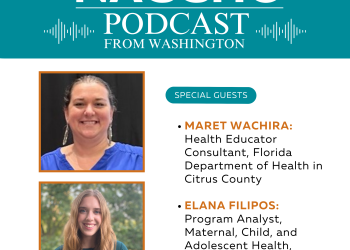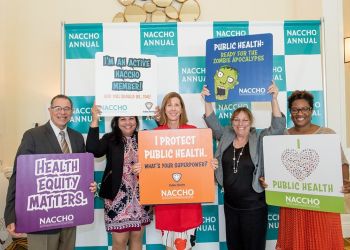Washington, DC, April 30, 2024 – The National Association of County and City Health Officials (NACCHO), the voice of over 3,300 local health departments across the country, released its 2023 Forces of Change Survey that assesses changes in local health department capacity and activities driven by public health trends. The study explored key factors currently experienced by health departments at the county, city, and district level, including staffing and budget changes, billing practices for clinical services, use of community health workers, partnerships and programs related to violence prevention and social determinants of health, and data modernization and outbreak analytics capacity.
The Forces of Change Survey data show both point-in-time information, as well as longitudinal changes. The findings help explain the opportunities and challenges faced by local health departments. Key findings include:
Staffing and Budget Changes Over Time – The study found that job losses at local health departments are on the rise, with 17% of local health departments losing at least one staff member in 2022 – a slight increase from the 14% of job loss in 2021, nearing pre-pandemic report levels. Nationally, more jobs were added than lost in 2022, but hiring seems to have slowed. In 2023, a similar trend shows that 16% of local health departments reported budget cuts – consistent with pre-pandemic figures reported in 2019 and 2020. Large local health departments were less likely to report current budget cuts (7%) than small and medium local health departments (14% and 21%, respectively). At the time of data collection, temporary federal funding was available to support the public health response to COVID-19. With the supplemental COVID-19 federal funding expiring and no further federal resources expected, it is not surprising that 20% of local health departments anticipate further cuts in their next fiscal year budgets. Sustained investment in local health departments is needed to ensure adequate staffing for public health activities beyond the emergency setting.
Billing for Clinical Services – Local health departments continue to provide important clinical services to their communities. Since 2014, nearly 9 in 10 local health departments have billed third-party payers for clinical services. However, the types of payers billed have shifted over time. In 2023, local health departments were less likely to bill only public payers and more likely to bill both public and private payers compared to previous years. The most common services for which local health departments billed private insurers were immunizations and family planning, whereas most did not bill any payers for chronic disease, tobacco cessation, or behavioral health/substance use services. Importantly 66% of local health departments that current bill third-party payers are considering or actively engaged to increase the extent they bill for such services. Although most local health departments reported that they billed third-party payers, NACCHO’s 2022 Profile of Local Health Departments study shows payments for clinical services make up only 6% of local health department revenue, nationally.
Community Health Workers – In 2023, more than half of local health departments employed (28%), had volunteers (9%), or partnered (37%) with organizations that had community health workers. Among local health departments that work directly with community health workers, 64% reported challenges identifying funding for these positions, with challenges in recruitment, training, and ensuring equitable pay cited as other common challenges. Despite these challenges, NACCHO’s 2022 Profile of Local Health Departments study estimates that 5,900 community health worker full-time equivalents (FTEs) are employed by local health departments across the country.
Social Determinants of Health and Multi-Sector Partnerships – In 2023, more than half of local health departments formed partnerships with local and state governments, community-based organizations, or business community partners and screened clients for a variety of social determinants of health. A few areas included food security, interpersonal safety, and housing instability. Specifically, nearly half of local health departments reported partnerships or collaborations with their local governments (49%) or community-based organizations (49%) on housing-related activities. More than two-thirds of local health departments reported collaborations with community-based organizations, and 55% with their local governments to address food insecurity.
Informatics and Data Modernization – Despite enhanced federal funding for data modernization activities, only 21% of local health departments report receiving supplemental funding for these activities. The vast majority (79%) reported that they still receive case notification from health care providers via telephone or fax, with over half receiving the information from electronic sources and 22% receiving data from wastewater surveillance. Differences remain across the local health department landscape, with 27% reporting not having access to an electronic health record platform and 11% of those that do having only one staff person assigned to this task, challenges most reported by small local health departments. Additionally, 40% reported not having a dedicated staff member to conduct outbreak analytics. At the same time, 95% said that infectious disease surveillance and outbreak response was considered a routine activity for their health departments. The data help underscore areas where increased investment and attention should be focused for future data modernization efforts, especially as outbreak threats such as measles and the avian “bird” flu virus continue to emerge.
# # #
About the 2023 Forces of Change Survey
For the 2023 survey, a total of 2,503 local health departments were included in the study population. Rhode Island was excluded from the study because the state health agency operates on behalf of local public health and has no sub-state units. A random sample of 1,200 local health departments were invited to complete the survey. NACCHO administered the survey from March to April 2023. Overall, the 2023 FOC survey had 532 local health departments respond, for a response rate of 44%. Deidentified data from the survey will be made publicly available through ICSPR’s data repository in late 2024. For access to prior years’ data and data use policies, please visit ICPSR. For more information about NACCHO’s FOC Survey, please visit www.naccho.org/forces.
About NACCHO
The National Association of County and City Health Officials (NACCHO) represents the over 3,300 local governmental health departments across the country. These city, county, metropolitan, district, and tribal departments work every day to protect and promote health and well-being for all people in their communities. For more information, visit www.naccho.org.






